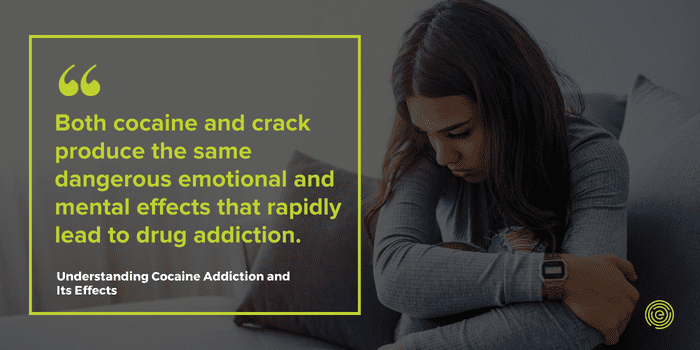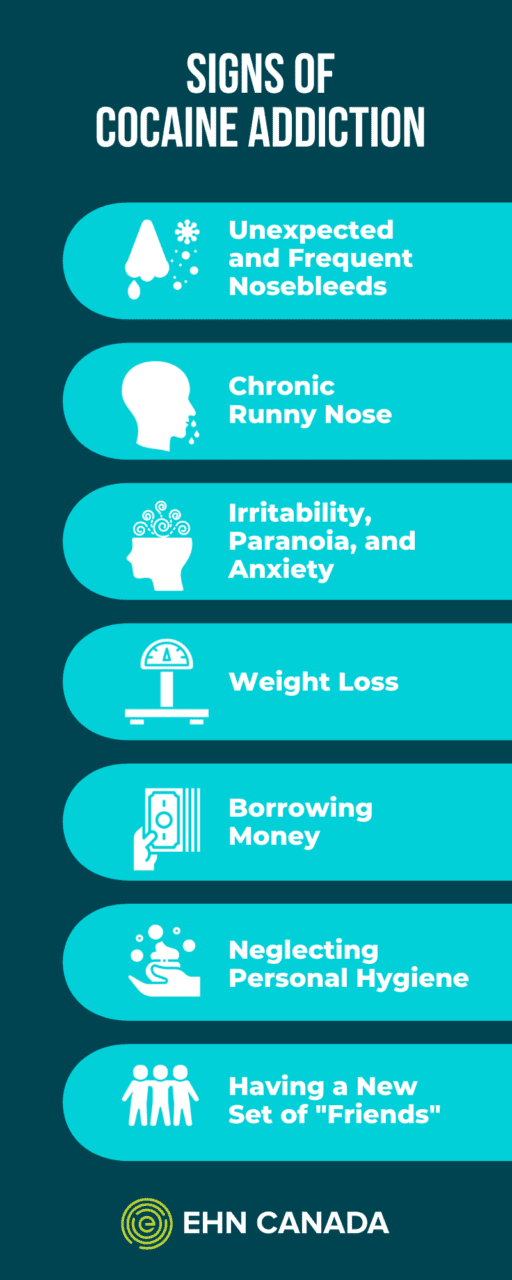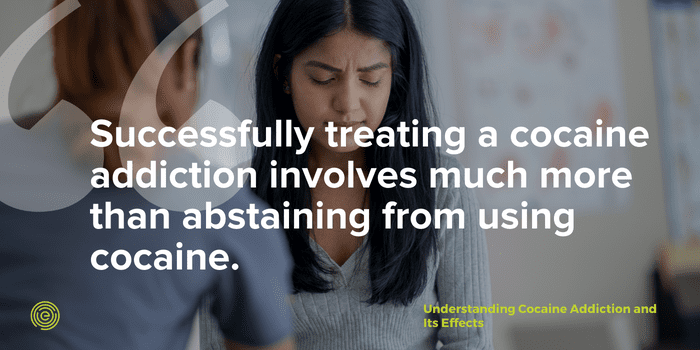Although the use of cocaine in Canada is low among adults – around two percent – the rate of cocaine abuse and addiction is increasing among young adults. Cocaine addiction specialists attribute this to the efficiency of cartels delivering cocaine through routes running through the U.S., the Caribbean, and Mexico.
Why is cocaine such a danger to a person’s short- and long-term health? How addictive is cocaine? Can you just stop using cocaine if you are addicted?
Derived from the coca bush, cocaine gives users an immediate, euphoric “rush” by flooding the brain with chemicals involved in regulating mood, motivation, and pleasure. Since substance use becomes a form of self-soothing when you feel stressed or anxious, cocaine is often the drug of choice to alleviate stress and anxiety that users find intolerable.
Cocaine Street Names
Cocaine, and its variations, is also known by other street names, including:
- Coke
- Crack
- Rock
- Blow
- Flake
- Snow White
- Icing
Crack refers to tiny, concentrated rocks of cocaine. Crack is smoked in a crack pipe but cocaine powder is snorted or injected. Both cocaine and crack produce the same dangerous emotional and mental effects that rapidly lead to drug addiction.

Physiological and Mental/Emotional Effects of Cocaine
Snorted or smoked cocaine causes adverse brain changes within 30 seconds of taking the first “hit” off a pipe. Injected cocaine causes these same changes in just five seconds. This includes:
- Tachycardia (rapid heartbeat)
- Blood pressure spike
- Increased respiratory rate (can sometimes border on hyperventilation)
- Dilated pupils
- Twitching muscles/uncontrollable muscle spasms
- Excessive sweating
- Inability to sit still or stop talking
- Euphoria/extreme optimism/sense of omnipotence
- Overly assertive or aggressive behavior
- Poor decision-making/lack of good judgment when making decisions

Like other types of substance addiction, cocaine addiction often causes the following long-term health issues:
- Heart attacks and strokes
- Bleeding ulcers
- Seizures/convulsions
- Various levels of brain damage/early onset of dementia
- Arrhythmia/heart failure
- Severe nosebleeds
- Loss of sense of smell for abusers who snort cocaine
- Bowel gangrene due to impaired blood flow to the gastrointestinal system
- Malnutrition/dramatic weight loss
- Hepatitis/HIV/blood infections (for intravenous cocaine users)
- Impaired immune system functioning
Research further indicates that combining alcohol and cocaine may be more dangerous than combining heroin and cocaine (speedball). The liver converts alcohol and cocaine into cocaethylene, a chemical that stays in the brain longer than cocaine by itself. This not only intensifies the physiological effects of cocaine but also increases the risk of heart attack, convulsion, and coma.
Cocaine addicts share certain characteristics and behaviours that may inadvertently reveal their addiction:
- Unexpected and frequent nosebleeds
- Chronic runny nose
- White powder around the nose
- Irritability
- Paranoia
- Anxiety
- Weight loss
- Borrowing money
- Inability to keep a job
- Neglecting personal hygiene
- Having a new set of “friends”
Cocaine addicts may or may not complain about other telltale signs of their addiction:
- Loss of sense of smell due to deterioration of nasal passages
- Having fever-like chills for no apparent reason
- Involuntary muscle twitches
- Insomnia
- Having audio or visual hallucinations
- Increasing sensitivity to loud sounds and bright lights
- Suffering extreme depression following a cocaine “binge” (using cocaine for several days in a row)
Cocaine is a central nervous system stimulant that inflicts damage on the body and brain by forcing the closure of blood vessels. When blood vessels narrow, the heart must work harder to pump blood throughout the body. Stressing the heart puts stress on all other organs, especially the kidneys, lungs, and brain. Over time, the constant lack of oxygenated blood flowing through the body causes necrosis (tissue death). Long-term cocaine abuse has even been shown to shrink the brain and provoke aneurysm (blood clots) development in the brain.
The Cycle of Cocaine Addiction
The cycle of cocaine addiction is a complex process that typically progresses through several distinct stages, beginning with experimentation and moving through regular use, dependence, and ultimately, addiction. Experimentation often starts with curiosity or peer pressure, with the individual trying cocaine for the first time without the intention to continue using it. However, the powerful euphoria and increased energy it provides can quickly lead to regular use, where the drug becomes a frequent part of the person’s life, often justified by the belief that it enhances social interactions or performance. As use becomes more frequent, the body begins to develop a tolerance to cocaine, necessitating larger doses to achieve the same high, thereby escalating the cycle toward dependence. At this stage, the person’s body and brain have adapted to the presence of the drug, experiencing withdrawal symptoms in its absence, which makes abstaining increasingly difficult.
The development of tolerance is a key factor in the progression from casual use to addiction. As the body becomes accustomed to the drug, the initial highs become harder to replicate, leading the individual to consume greater quantities in an attempt to recapture the euphoria. This tolerance contributes to the cycle of addiction, locking the user into a pattern of escalating use. The highs associated with cocaine are indeed intense, offering feelings of supreme confidence, alertness, and energy. However, these are swiftly followed by devastating lows, characterized by depression, anxiety, exhaustion, and a profound craving for more of the drug to alleviate these negative feelings. This cycle of extreme highs and lows not only takes a toll on the individual’s physical health, leading to serious heart, brain, and respiratory issues, but also devastates their mental health, relationships, and financial stability, illustrating the destructive nature of cocaine addiction.
What Causes Addiction to Cocaine or Crack?
Research into why some people develop a drug addiction involves the following factors:
- Age: using cocaine at a young age (between 12 and 30 years old) increases the risk of a cocaine addiction
- Method: injecting cocaine causes addiction faster than snorting or smoking cocaine
- Genetics: having parents, grandparents, or other close relatives who abuse drugs is a definite risk factor
- Mental health: people suffering from PTSD, depression, personality disorders, or bipolar disorder are at high risk for addiction
- Pre-existing medical conditions: addiction often starts when the person tries to self-medicate for a chronic pain condition or mental illness. If a cocaine addict has a serious, undiagnosed health issue, the risk of suffering a heart attack and even death increases significantly.
- Environmental: growing up in households and neighborhoods populated with drug users and dealers encourages experimentation with drugs.
One danger of cocaine abuse that isn’t well-known is the difficulty encountered by recovering cocaine addicts to avoid relapse. The reason why former cocaine addicts continue to have cravings even after years of abstinence involves the long-term neurobiological damage that cocaine inflicts on the brain.
Studies have found that cocaine can permanently change the structure of brain cells (neurons). This change allows neurons to connect abnormally with other cells via branch-like links (dendrites). The result of this branching out to signal other brain cells increases the release of a chemical called NAc, which drives the behavioral and physical transformations associated with cocaine addiction.
Although substance addiction does not happen overnight, it can happen within just several weeks of using cocaine, heroin, or methamphetamine. The term “addiction” refers to how quickly a person develops a tolerance to drugs and the appearance of withdrawal symptoms when that person stops taking them. When you develop a tolerance to cocaine, you need more and more of the drug over time to experience the powerful euphoria you felt the first time you used cocaine.
Treatment for addiction of drugs addresses the underlying causes of a substance use disorder, treating withdrawal symptoms with medications, avoiding relapse, and coping with severe anxiety and depression after addiction. Anyone who thinks they can just “try” cocaine and not get addicted or use cocaine only on the weekends should be aware that the brain doesn’t just bounce back after a short period of abstinence.
In fact, cocaine-related brain impairment involves significant shrinkage of brain ventricles that could create damaged or completely empty spaces in the brain. Snorting cocaine regularly for more than a few weeks will begin the process of brain atrophy and decline.
Signs of cocaine withdrawal usually begin four to six hours after last using cocaine. Withdrawal symptoms are a definite indicator that someone is addicted to cocaine and should seek treatment as soon as possible.
Cocaine withdrawal symptoms include:
- Anxiety, restlessness, fidgeting
- Inability to focus or think clearly (similar to cognitive signs of ADHD)
- Lack of motivation/completing normal tasks are nearly impossible)
- Depression
- Overwhelming cravings for cocaine
- Moodiness/irritability
- A slight increase in appetite accompanied by nausea
- Insomnia
- Flu-like symptoms (painful joints, runny nose, fever)
- Panic attacks
- Paranoid thoughts
Cocaine addicts should never try to go “cold turkey”. Serious health problems can suddenly occur that demand emergency medical attention. The possibility of heart attack, seizures, shock, and acute psychotic episodes while withdrawing from cocaine is real and dangerous. Cold turkey methods for beating an addiction to any drug never work. Successfully treating a cocaine addiction involves much more than abstaining from using cocaine.

Can Medications Treat Cocaine Addiction?
Currently, no medications are available that specifically treat cocaine addiction. In the past, doctors thought drugs blocking dopamine surges in the pleasure/reward center of the brain might help relieve cravings for cocaine. However, studies now show that cocaine also impacts levels of serotonin, glutamate, GABA, and other neurotransmitters involved in the addiction process. Several medications are being researched for possible treatment of cocaine addiction but they have yet to be approved by the appropriate government agencies.
Behavioral Therapies for Cocaine Addiction
Contingency management
Contingency Management (CM) is a type of behavioral therapy that uses motivational incentives to help people overcome a substance abuse disorder. For example, if someone in rehab provides a clean urine test, they are rewarded with tokens that can later be exchanged for free dinners at a restaurant, free gym membership, or anything else that promotes a sober, healthy lifestyle. CM works well for retaining patients in a treatment program and addresses the needs of diverse cocaine addicts–from pregnant women to parents raising children to homeless individuals lacking resources.
Cognitive Behavioural Therapy
Cognitive Behavioural Therapy (CBT) is an effective therapy for anyone struggling with a substance abuse disorder. CBT shows recovering addicts how to correct self-defeating thought patterns, resolve psychological causes of substance abuse disorder, and quickly recognize when they are feeling stressed in “trigger” situations. Therapists skilled in CBT also teach patients coping skills that help them successfully deal with triggers that could lead to relapse.
Eye Movement Desensitization and Reprocessing (EMDR)
Since many people with an addiction to drugs have experienced childhood abuse and trauma, EMDR is proving to be a valuable therapy for cocaine addicts who want to get sober and heal. Originally developed to treat people with posttraumatic stress disorder (PTSD), EMDR focuses on helping individuals process and resolve memories of trauma. The creator of EMDR discovered that when patients focus on a specific traumatic memory while incorporating rapid eye movements, a process called bilateral stimulation occurs that minimizes the intensity of the memory. EMDR is further useful for treating anxiety and depression after addiction
Finding Support During Recovery
The journey of overcoming cocaine addiction is complex and often requires significant support. The cycle of addiction encompasses a progressive journey through various stages: experimentation, regular use, dependence, and ultimately, addiction. It’s important to understand that seeking help at any stage can be pivotal in turning things around.
- The Importance of Seeking Help: Acknowledging the need for support is a sign of bravery and a major step towards reclaiming control over your life. Reaching out for help opens the door to resources that are essential for addressing the complex factors driving addiction.
- Support Groups: Mutual support groups like Narcotics Anonymous (NA) offer safe, understanding spaces for individuals to connect with those who share similar struggles. These groups provide community, accountability, and practical strategies for maintaining long-term recovery. Both in-person and online meetings are available to enhance accessibility.
- Therapy: Individual therapy provides a confidential space to explore the root causes of addiction, develop healthier coping mechanisms for cravings, and address underlying issues that may have contributed to substance use. Cognitive Behavioral Therapy (CBT) is particularly useful for managing addictive behaviors. Group therapy adds a powerful community aspect, allowing you to learn from and support others in their recovery while receiving professional guidance.
Remember, seeking support is a sign of strength in recovery. These resources provide essential tools for addressing the physical and emotional complexities of addiction, fostering connection, and crucially, building a foundation essential for long-term recovery success.
Defeating Cocaine Addiction Starts with Treatment
Cocaine is one of the most dangerous addictive substances known and will inflict permanent damage to your brain and body. Defeating a cocaine addiction and achieving long-term sobriety involves entering an addictions outpatient program, remaining committed to attending all sessions with a substance abuse professional, and adhering to medical advice provided by an addiction physician.
If you or someone you know is using cocaine, don’t wait to get help. Please visit EHN’s online program for addiction and call our online program hotline at 1-866-963-6343. With a wide range of exceptional online counseling programs, EHN Canada is helping thousands of people get the help they need to overcome a cocaine addiction.



